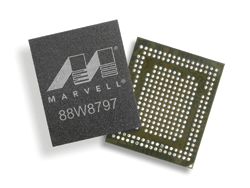Designers can take advantage of Bluetooth’s promise in an entirely new range of devices
BY RAMYA CHANDRASEKARAN
Technical Marketing Engineer
Marvell Semiconductor
www.marvell.com
Over the past decade, Bluetooth has become an omnipresent commodity technology in consumer electronics peripherals. From mobile headsets to PC mice and keyboards, Bluetooth, coupled with other key Wi-Fi technologies, has helped free end users from hard-wired devices, enabling new flexibility and freedom within the wireless lifestyle. Still, the implementations of Bluetooth have been limited, due primarily to the associated high power drain.
Until recently, current Bluetooth peripherals were well-suited only to devices that are charged on a daily basis. Within consumers' personal network of devices, however, there exists a huge market for low-power, short-range devices such as body sensors, medical devices, and thermometers.
Now, thanks to the Bluetooth SIG’s July 2010 formal adoption of Bluetooth Core Specification Version 4.0, with the hallmark feature of Bluetooth low energy (BLE), chip designers have the opportunity to take advantage of Bluetooth’s promise in an entirely new range of devices. BLE devices with can potentially operate for a year using small batteries.
About Bluetooth Low Energy
BLE, the main feature of Bluetooth 4.0, operates in the same spectrum range (2402-2480 MHz) as classic Bluetooth, but uses a different set of channels. Devices can either be dual- or single-mode. Dual mode devices will integrate BLE into existing Bluetooth designs and cater to both kinds of use cases, while single-mode BLE sticks to low power.
BLE requires a hardware upgrade and cannot be made backward compatible with older devices. However, if the new device uses dual-mode Bluetooth 4.0, backward compatibility can be achieved.
Some specifications:
Less than 20 mA peak current consumption is needed for transmit from a single-mode BLE device. Typically 15 mA. Sleep current is only 1 uA – but that may not happen often.The signal range for BLE runs up to 200 m and output power is about 10 mW at 2.4 GHz.Some Bluetooth Low Energy ICs are already sampling and will be available in commercial products before the end of 2011

The Marvell Avastar 88W8787 SoC handles simultaneous operation of 802.11a/g/b and 802.11n WLAN, Bluetooth 3.0 + High Speed (HS), and FM transmit and receive.
Use cases that will benefit from low-power Bluetooth
Mobile devices
The integration of BLE technology into mobile products promises to open up a range of new applications. For example, the functions of classic single connection devices such as remote controllers and gaming accessories can be integrated with devices like mobile phones and tablets through the introduction of dual mode BLE into combination radios that feature integrated Wi-Fi, GPS, and, FM, and Bluetooth LE.
PCs and Accessories
Short range applications like keyboards and mice that utilize traditional Bluetooth technology will benefit from significantly increased battery life of a BLE implementation.
Healthcare and sports
This is one of the primary new use cases for Bluetooth low energy. Wireless thermometers and blood pressure meters can send data to the healthcare provider’s cell phone or computer and vital statistics like heart rate and blood sugar can be monitored continuously without user intervention. By connecting these low-power monitoring devices a wireless and seamless health monitoring system for patients and health care providers can be achieved.
Home automation
BLE is a potential candidate technology for devices like intelligent washing machines or sprinkler systems that can be controlled wirelessly for home automation and smart energy management. ■
The Marvell Avastar 88W8787 SoC handles simultaneous operation of 802.11a/g/b and 802.11n WLAN, Bluetooth 3.0 + High Speed (HS), and FM transmit and receive.
Advertisement
Learn more about Marvell Semiconductor





